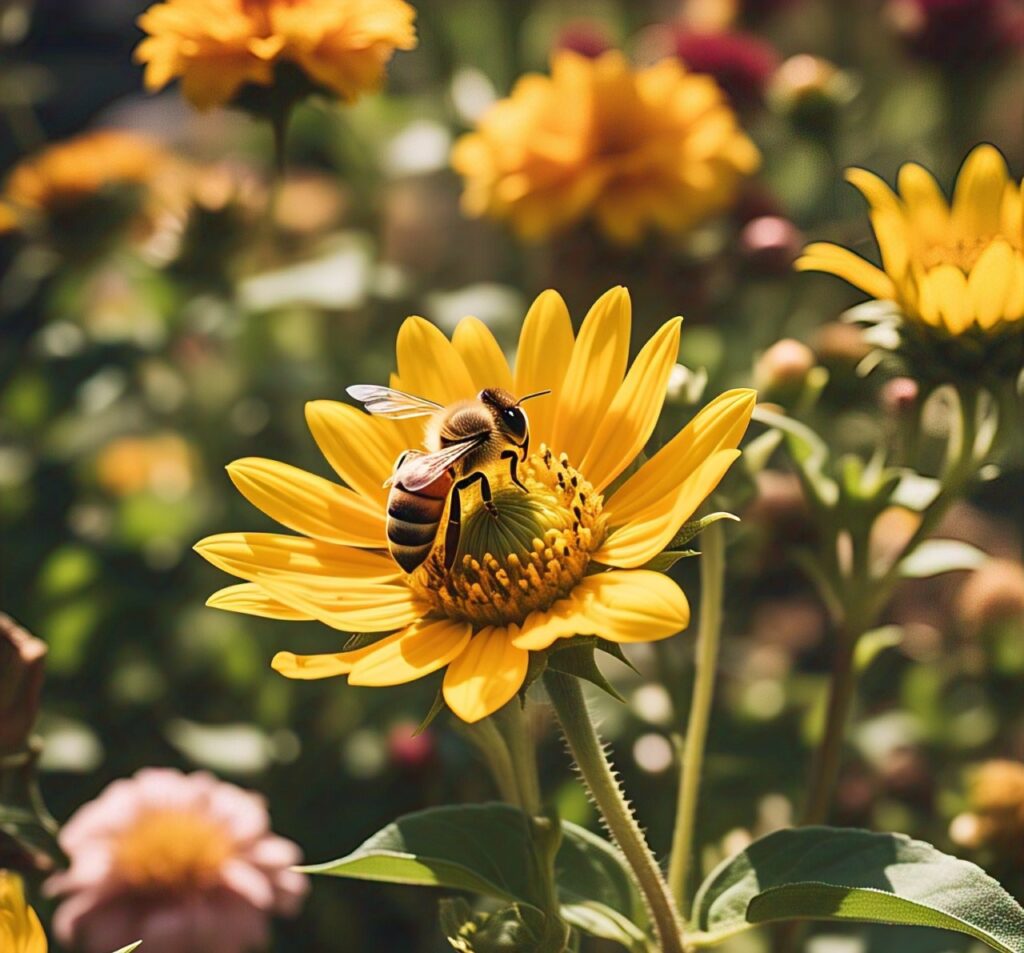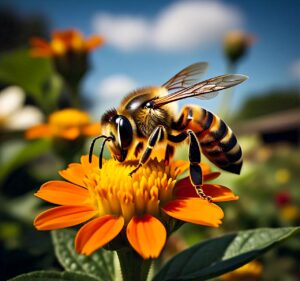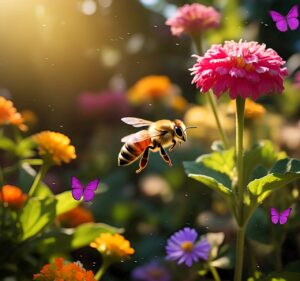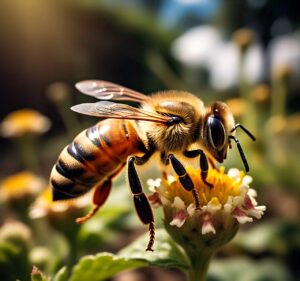The Lifespan of a Bee 2025: Incredible Story of Hard Work, Dedication, and Sacrifice
Let’s get insight into the lifespan of a bee and how much nectar or honey a single bee collects during its lifetime. Bees are incredible creatures that play a vital role in pollination and honey production. Their lives are devoted to the service of the hive and the gathering of nectar, which eventually becomes honey.

Development from egg to emerging bee varies among queens, workers, and drones. Queens emerge from their cells in 15–16 days, workers in 21 days, and drones in 24 days. Only one queen is usually present in a hive. New virgin queens develop in enlarged cells through differential feeding of royal jelly by workers.
When the existing queen ages or dies or the colony becomes very large, a new queen is raised by the worker bees. When the hive is too large, the old queen will take half the colony with her in a swarm. This occurs a few days before the new queen emerges. If several queens emerge, they will begin piping (a high buzzing noise), signalling their location for the other virgin queens to come fight. Once one has eliminated the others, she will go around the hive, chewing the sides of any other queen cells and stinging and killing the pupae.
The queen takes one or several nuptial flights to mate with drones from other colonies, which die after mating. After mating, the queen begins laying eggs. A fertile queen can lay fertilised or unfertilised eggs. Each unfertilized egg contains a unique combination of 50% of the queen’s genes[1] and develops into a (haploid) drone. The fertilised eggs develop into either (diploid) workers or queens (if fed exclusively royal jelly).
Lifespan of a Bee
1. Worker Bees

The lifespan of a worker bee, the female bee responsible for nectar collection and hive maintenance, is relatively short. On average, a worker bee lives for about 4 to 6 weeks during the summer months. Their lives are filled with various tasks, including foraging for nectar, guarding the hive, and nursing the young.
2. Queen Bees
Queen bees, on the other hand, have a longer lifespan. A healthy queen bee can live for several years, with some queens living up to five years or more. Their primary role is to lay eggs and ensure the hive’s reproduction.
3. Male Bees (Drones)
Male bees, or drones, have the shortest lifespan. Their lives are limited to a few weeks during the breeding season, typically spring and early summer. Their sole purpose is to mate with a queen bee.
 Nectar-Honey Collection by Worker Bees
Nectar-Honey Collection by Worker Bees
The amount of nectar collected by a single worker bee during its lifetime varies depending on several factors, including the availability of nectar sources and the bee’s age and health. However, on average, a single worker bee may collect and process around 1/12th of a teaspoon of nectar in its lifetime. This nectar is then converted into honey through a process of regurgitation, evaporation, and storage in the hive.
Honey Production by the Hive
The collective effort of thousands of worker bees in a hive leads to the production of honey. It’s estimated that a hive can produce between 30 to 60 pounds (13.6 to 27.2 kilograms) of honey in a single year, depending on environmental factors and the size and strength of the colony.
The Remarkable Lives of Bees

The lives of bees, especially worker bees, are short but filled with industrious activity. Each bee’s contribution to nectar collection and honey production may seem small, but when combined with the efforts of the entire hive, it results in the sweet and golden treasure we know as honey. Bees’ remarkable work highlights the importance of these tiny creatures in our ecosystems and the production of one of nature’s most cherished foods.
FAQs
- What happens to worker bees when they reach the end of their lifespan?
- When worker bees near the end of their lifespan, their roles change. They may take on tasks within the hive, such as cleaning or caring for the queen’s offspring, or even become foragers if they haven’t performed that role yet.
- How much nectar is needed to produce a pound of honey?
- It takes approximately 2 million flowers and 55,000 miles (88,514 kilometres) of flight for honeybees to collect enough nectar to produce one pound of honey.
- What factors can influence the lifespan of a bee?
- The lifespan of a bee can be influenced by factors like the time of year (season), exposure to pesticides or diseases, and the availability of nectar sources.
- Do all worker bees in a hive collect nectar and make honey?
- No, not all worker bees in a hive are foragers responsible for nectar collection. The hive’s workforce is divided into different castes, each with specific roles, including foragers, nurse bees, and guard bees.
- How long does a bee spend collecting nectar each day?
- Bees can spend a significant portion of their day, usually several hours, collecting nectar from flowers and transporting it back to the hive. The amount of time spent on this activity can vary depending on factors like the distance to nectar sources and the availability of nectar.
There are three types of honey bees in a hive: the queen bee, worker bees, and drone bees. Each type of bee has a specific role in the hive.
Queen bee
The queen bee is the largest bee in the hive and the only bee that can lay eggs. She has a lifespan of 2-3 years. The queen bee’s primary duty is to lay eggs to ensure the survival of the colony. She can lay up to 2,000 eggs per day.
Worker bees
Worker bees are female bees that make up the majority of the hive. They have a lifespan of 5-6 weeks during the active summer season. Worker bees are responsible for all of the tasks in the hive, including:
- Collecting nectar and pollen from flowers
- Building and maintaining the hive
- Feeding the queen and larvae
- Protecting the hive from intruders
Drone bees
Drone bees are male bees. They have a lifespan of 6-8 weeks. The only job of drone bees is to mate with the queen bee. After mating, drone bees die.
The life span of honey bees can vary depending on several factors, including the species of bee, the climate, and the availability of food. However, the average lifespan of a honey bee is 5-6 weeks.
Honeybees play an important role in the ecosystem by pollinating plants. When a bee visits a flower, it collects pollen on its body. The bee then carries the pollen to other flowers, which helps to fertilise them. Pollination is essential for plant reproduction, and it also helps to produce the fruits and vegetables that we eat.
We can all help to protect bees by planting bee-friendly flowers and trees in our yards and gardens. We can also avoid using pesticides in our yards and gardens, as pesticides can harm bees.
The term “king bee” is often used to refer to the leader of a group, but it is not accurate in the context of honey bees. Honey bees are an eusocial species, which means that they live in colonies with a complex social structure. The queen bee is the only bee in the hive that can lay eggs, and she is the head of the colony. The worker bees and drone bees are all her offspring.
Drone bees are male bees, and their only job is to mate with the queen bee. After mating, drone bees die. Therefore, drone bees do not play a significant role in the colony, and they are not the leaders.
The term “king bee” is sometimes used to refer to the largest and strongest drone bee in the hive, but this is not an official term. It is more accurate to refer to drone bees as male bees.
Here is a summary of the different types of honey bees and their roles in the colony:
| Type of bee | Lifespan | Role |
| Queen bee | 2-3 years | Lay eggs |
| Worker bee | 5-6 weeks | Collect nectar and pollen, build and maintain the hive, feed the queen and larvae, and protect the hive from intruders |
| Drone bee | 6-8 weeks | Mate with the queen bee |
In the bee colony’s social structure, the queen bee is the central figure and is often considered the “queen” of the hive due to her crucial role in laying eggs and maintaining the colony’s population.
دلکش آرر راک 2025 میں دریافت کریں: سندھ کے دل میں ایک پراسرار عجوبہ


